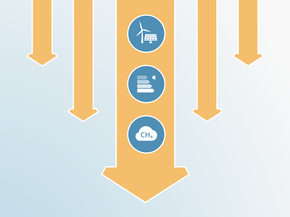Country summary
Overview
With significant progress in renewable energy capacity installation—ranking fourth in the world in 2024 in cumulative capacity—and comprehensive policy measures, India has reached a turning point in its power sector, with non-fossil sources supplying the majority of new electricity generation in 2024–25 for the first time. But reliance on coal power continues to be a drag on ambition. In addition to building substantial new coal power capacity, the government is pushing for increased domestic coal production and utilisation of existing thermal power plants.
Although progress toward implementation of the National Electricity Plan 2023 (NEP2023) targets has also been slower than projected, India has recently reached its NDC target of 50% non-fossil capacity five years early. However, the generation share of non-fossil sources is stagnating at around 25%. Given the high share of fossil fuels in the primary energy mix and electricity generation, and with no clear plan for a transition away from fossil fuels, we continue to rate India’s current policies as “Insufficient”.
To ensure a fair contribution to the global climate crisis, India’s emissions would need to stay below the emissions projected under current policies, and with international support, it could expedite faster reductions. The CAT’s overall rating of India’s climate targets and action remains “Highly insufficient”.
India’s 2030 emissions under current policies are 8-11% higher than our last assessment and overall emissions are still expected to rise beyond 2030. While renewables are playing a bigger role in meeting new demand, the sheer size of the existing fossil fuel base, coupled with continued fossil capacity growth, means the overall reliance on fossil power generation has not shifted. Progress toward implementation of the National Electricity Plan 2023 (NEP2023) targets has also been slower than projected, with more than 100 GW of additional renewable capacity still needed by 2026–27 to meet interim milestones of ~350GW. This slow progress of NEP2023 is captured in the upper bound of our current policy pathways.
For a long time, India’s rising electricity demand outpaced renewable generation growth, forcing annual increases in fossil fuel use. However, 2024–25 marked a real turning point when non-fossil sources (renewables and nuclear) contributed the majority of additional electricity generation, with renewables alone supplying nearly a third of that. This signals a potential break from the fossil-dependence spiral.
This shift is supported by record renewable investments, coal’s share of installed capacity falling to 47% in 2024, rapid rooftop solar expansion, and over 73 GW of new utility scale solar and wind capacity tendered. Importantly, renewables—especially solar—are becoming cost-competitive with coal, but the falling price of renewables alone is unlikely to drive a large-scale transition, and a major shift from coal still requires a strong policy push.
Despite the ambition reflected in the NEP2023, its implementation remains uneven. While access to capital for renewable energy has improved with an effective tendering process, addressing implementation and policy barriers is crucial to bridging the gap between auction success and projects coming online.
Although overall coal capacity has continued to stay below 50%, its share in total generation is continued to be around 75% and to be aligned with the 1.5°C temperature limit coal generation must drop to 17-19% by 2030. India has been witnessing a surge in summer electricity demand in recent years due to extreme heatwaves. As a result, the increase in renewable energy capacity is barely able to keep up with the cooling energy demand, and the generation share of coal remains at 75%.
Another challenge is meeting the peak demand during non-solar hours, which requires more robust grid infrastructure and storage, the absence of which has led to an increasing utilisation of gas plants over the past year to meet peak demand, amid rising cooling needs.
The country’s continued record-high coal production and construction of new coal plants risk locking India into a carbon-intensive future. While India has already reached its NDC target of 50% non-fossil capacity ahead of 2030, the lack of a coal phase-out plan, insufficient storage development, and growing energy needs driven by climate impacts constrain deeper decarbonisation.
Meanwhile, government policies continue to expand fossil gas use in residential and power sectors through city gas networks and subsidised connections. This increasing reliance on gas, often - and incorrectly - framed as a cleaner alternative to coal, risks creating new fossil fuel lock-ins and undermines the scale of transformation needed for a 1.5°C aligned energy transition.
India has not yet submitted its 2035 target, and it can still achieve both of its 2030 targets under current policies and action. In essence, in the 2022 update of its NDC, India replaced its unambitious first mitigation targets with targets close to its current level of climate action. However, with each of our updates, emissions under current policies in 2030 are increasing, an indication that India is drifting further from a pathway aligned with limiting warming to 1.5°C. This trend highlights the urgent need for stronger policy implementation and more ambitious targets to reverse the upward trajectory of projected emissions.
Some of the recent positive developments in terms of climate change mitigation policies include:
- Non-fossil sources supplied the majority of new electricity generation in 2024–25 for the first time, marking a potential break from fossil dependency.
- India has surpassed 50% non-fossil installed capacity, and achieved its conditional NDC target (50% by 2030) well ahead of schedule.
- Record investment in renewables, with a 91.5% increase between 2023 and 2024, and over 73 GW of utility scale solar and wind capacity out for tender.
- The rooftop solar installations doubled in FY 2023–24 and cumulative capacity reached 22 GW, driven by supportive policies like PM Surya Ghar.
- The policy push for domestic PV module manufacturing is increasing the uptake of domestic PV modules, along with capitalising on export markets.
Despite these promising developments, several critical gaps and structural challenges remain that could undermine long-term progress if left unaddressed:
- Effective and ambitious 2035 target: India should begin by adopting a national, economy-wide GHG emissions target to enhance clarity, consistency, and accountability under the Paris Agreement. This target must clearly distinguish between unconditional commitments—those India intends to meet with domestic resources—and conditional elements, which depend on international support;
- Develop a clear and time-bound coal phase-out strategy to avoid locking in carbon-intensive infrastructure and aligning generation with a 1.5°C pathway. Coal still accounts for over three quarters of electricity generation, despite its share of capacity declining;
- Avoid locking in a dependency on fossil fuel imports and set up a plan for transitioning away from all fossil fuels in end-use sectors, such as industry, buildings, transport;
- Strengthen the renewable energy installation-to-generation transition, as the generation share of renewables (including larger hydro) remains stagnant at ~22% despite significant capacity growth—pointing to integration challenges, particularly low storage capacity;
- Address policy and implementation bottlenecks in utility-scale solar projects, such as transmission delays, land acquisition hurdles, and renegotiation of power purchase agreements, which are slowing project commissioning despite strong auction activity;
- Reassess the policy push for LNG in trucking, which offers limited climate benefit and risks locking in fossil fuels. Instead, adopt a long-term strategy for transitioning to zero-emission trucks.
- Scale up EV infrastructure and further support EV adoption in 4-wheeler segment, where adoption remains very low (~2.5% of all new 4 wheeler sales in 2024). Expanding public charging infrastructure (currently at 25,202 stations) is critical to enabling wider EV uptake.
- Devise a long-term decarbonisation strategy for its building sector to address the rapidly rising demand for cooling energy.
Description of CAT ratings
The CAT rates each country’s targets and policies against (1) its fair share contribution to climate change mitigation considering a range of equity principles including responsibility, capability and equality, and (2) what is technically and economically feasible using modelled domestic pathways which in absence of a better method are based on global least-cost climate change mitigation.
Comparing a country’s fair share ranges and modelled domestic pathways provides insights into which governments should provide climate finance and which should receive it. Developed countries with large responsibility for historical emissions and high per-capita emissions, must not only implement ambitious climate action domestically but must also support climate action in developing countries with lower historical responsibility, capability, and lower per-capita emissions.
The CAT rates India’s climate targets and policies as “Highly Insufficient”, indicating that India’s climate policies and commitments are not consistent with the Paris Agreement’s 1.5°C temperature limit and lead to rising, rather than falling, emissions.
India’s second NDC of 2022 strengthened its targets on paper but will not drive real world emission reductions beyond its current level of climate action. Its emissions intensity target is “Insufficient” when compared to India’s fair share contribution.
We rate India’s target of 50% non-fossil capacity by 2030, conditional on international support, as “Highly insufficient” when compared to a modelled 1.5°C emissions pathway for the country and its current power sector plans already exceed this target.
India needs to adopt stronger targets that will drive actual emissions reductions and accelerate climate policy implementation. The country will need international support to get onto a 1.5°C pathway.
We rate India’s current policies and action as “Insufficient” compared to its fair share contribution.
The “Insufficient” rating indicates that India’s policies and action in 2030 needs substantial improvements to be consistent with limiting warming to 1.5°C. If all countries were to follow India’s approach, warming would reach over 2°C and up to 3°C.
India has ambitious renewable energy plans as outlined in the National Electricity Plan 2023 (NEP2023) aiming for a share of installed renewable capacity of 57% and 66% in 2026-27 and 2031-32, respectively.
The share of renewable energy capacity (including large hydro) in India reached 45%, ranking it fourth in the world in cumulative renewable energy capacity installations in 2024, after China, the US and Germany. The NEP2023 is reflected in the lower bound of our current policy and action pathway. However, the progress towards non-fossil generation as planned under NEP2023 is slow and that has been reflected in the upper bound of our current policy and action pathway.
India has witnessed a steady rise in renewable energy deployment, particularly in utility-scale and rooftop solar, contributing to a falling share of coal capacity to below 50% for the first time in 2023, and further to 47% in 2024. Despite this, renewables are struggling to match the rapid increase in electricity demand, exacerbated by extreme heat and rising peak loads. As a result, the share of non-fossil sources in total electricity generation—including large hydro—has stagnated at around 25%, showing no year-on-year improvement.
Investment in renewable energy projects in India have increased by over 91.5% between 2023 and 2024, with fossil fuel companies also diversifying their investments into the renewable sector. Large-scale solar and wind projects are accelerating, with 73 GW of capacity under tender, surpassing the government's annual target of 50 GW.
Despite this, India has not committed to phasing out coal power or fossil gas. While the country boasts some of the lowest renewable tariffs globally—even when including storage—falling prices alone are unlikely to drive a large-scale transition from coal without strong policy intervention.
The National Electricity Plan indicated a temporary halt in coal capacity addition, but current capacity under construction exceeds the threshold stated in these plans and coal production hit a record one billion tonnes in FY 2024–25. While new gas power projects have been abandoned, the utilisation of existing gas power plants has increased to meet energy demand driven by severe heat stress.
The government continues to advance its green hydrogen policy with its updated National Green Hydrogen Mission. The policy has set a target of 5 Mt per annum of green hydrogen production by 2030 with associated renewable energy capacity of 125 GW.
India is set to establish its own carbon market by mid-2026 as the government has adopted regulations for its compliance carbon market under the Carbon Credit Trading Scheme (CCTS). The proposed system will include an emissions intensity target, similar to the previous cap-and-trade system known as Perform, Achieve, and Trade (PAT). However, the draft rules do not propose an absolute reduction target.
At COP26, India signed the 100% EV declaration, aiming to increase the share of electric vehicle (EV) sales penetration to 30% in private cars, 70% in commercial vehicles, 40% in buses, and 80% in two- and three-wheelers by 2030. In 2024-25, electric two-wheelers and three-wheelers comprised over 86% of total EV sales and reached respectively 6% and 23% of EV penetration in total sales of this segment. India has also established an objective to elevate the proportion of EV private car sales to 30% in total sales of this segment by 2030, however, progress under this segment is slow, 2.5% of the sales share in FY 2024-25.
Phase III of Faster Adoption and Manufacturing of Electric Vehicles (FAME III) – has been replaced with the PM Electric Drive Revolution in Innovative Vehicle Enhancement (PM E-DRIVE) scheme which would provide INR 36.79 billion (USD 438 million) in incentives to promote battery-powered two-wheelers, three-wheelers, ambulances, trucks, and other advanced EVs.
Our full policy and action analysis is here.
India’s NDC has three main elements:
- An emissions-intensity target of 45% below 2005 levels by 2030;
- A target of achieving 50% cumulative electric power installed capacity from non-fossil fuel-based energy resources by 2030; and
- Creation of a carbon sink of 2.5 to 3 GtCO2e through additional forest and tree cover by 2030.
While India indicated in its updated NDC that achieving the 50% non-fossil capacity target would require international support, it is already on track to achieve 60% or more non-fossil capacity by 2030 under current policies.
We rate this target as “Highly insufficient” when compared to the level of reductions needed in India under modelled domestic pathways to be consistent with limiting warming to 1.5°C, indicating that substantial improvement is needed and India will require international support to get onto a 1.5°C pathway.
We interpret India’s emissions-intensity target as being its unconditional contribution to limiting warming to 1.5°C. We rate this target against what India’s fair share contribution should be and find it to be “Insufficient.”
The “Insufficient” rating indicates that India’s unconditional target in 2030 needs substantial improvements to be consistent with limiting warming to 1.5°C. India’s target is at the least stringent end of what would be a fair share of global effort and is not consistent with the 1.5°C limit, unless other countries make much deeper reductions and comparably greater effort. If all countries were to follow India’s approach, warming would reach over 2°C and up to 3°C.
The quantification of this target varies depending on how GDP is measured and assumptions made about 2030 projections. The transparency of India’s target could be improved with further information on these elements.
In 2016, India had a net carbon sink of 308 MtCO2e. India's target for its land and forestry sector remains unchanged in its updated NDC as it plans an additional 2.5–3 GtCO2e of carbon sink by 2030 through additional forest cover. Several policies and measures were adopted under overarching framework of the National Mission of Green India.
In its National Forest Policy of 1988 India has set a target of bringing 33% of its geographical area under forest cover. As of 2021, forest and tree cover accounts for 24.6% of the country’s geographical area, an only marginal increase since 2005 (21%).
At COP26 in 2021, Prime Minister Narendra Modi announced a 2070 net zero target for India, and during COP27 India submitted its Long-term Strategy for Low Carbon Development (LT-LEDS). We evaluate the net zero target as “Poor”.
Our full net zero analysis is here.
Further analysis
Latest publications
Stay informed
Subscribe to our newsletter




